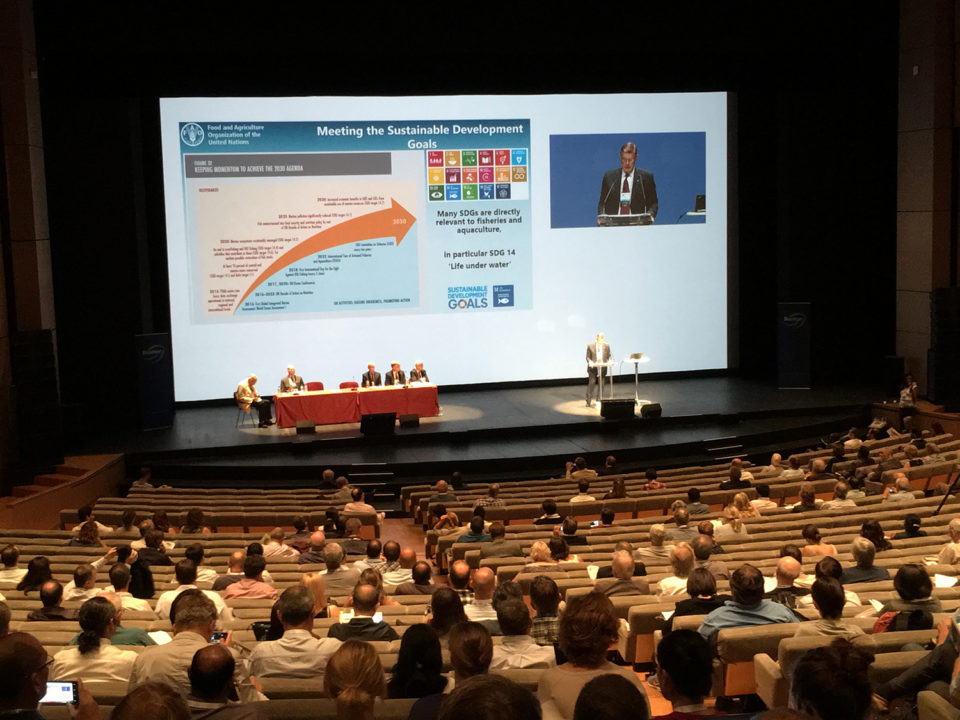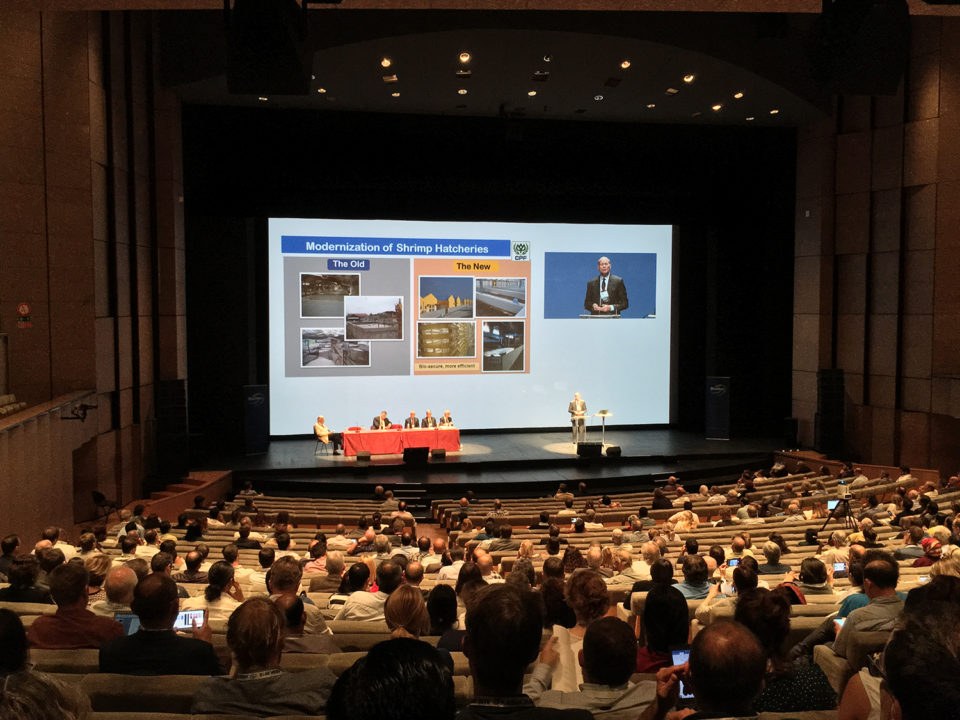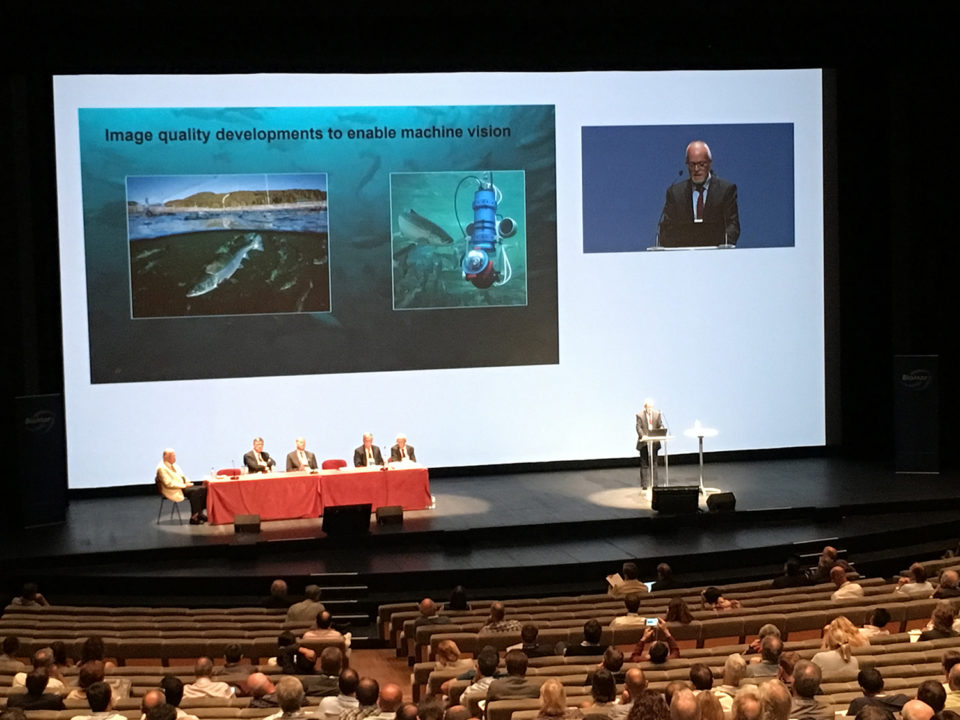Summaries of keynote speakers’ presentations at AQUA 2018

AQUA 2018, the joint global aquaculture event organized every six years in Europe by the World Aquaculture Society (WAS) and the European Aquaculture Society (EAS), was held in the beautiful city of Montpellier, France, in late August.
The event brought together more than 3,000 participants and more than 200 exhibitors representing stakeholders from every segment of the global aquaculture production and marketing chain, and included academics, students, representatives from every ancillary industry, government officials and others.
“Aquaculture is one of the most important food production industries in the world,” said Dr. Patrick Sorgeloos, AQUA 2018 conference chair. “Aquaculture is the most efficient producer of high quality food and contributes to global health and wealth. Aquaculture respects the environment, creates employment and offers significant investment opportunities.”
Following are summaries of the three keynote plenary presentations.
Árni M. Mathiesen, Assistant Director-General, Fisheries and Aquaculture Department, Food and Agriculture Organization of the United Nations (FAO)
In his plenary talk “FAO Update on the Status of World Aquaculture,” Mathiesen discussed the state of world aquaculture from the perspective of the recent SOFIA 2018 report (http://www.fao.org/3/i9540en/I9540EN.pdf).
Global fish production reached a peak of about 171 million tons in 2016, with aquaculture representing about 47 percent of the total and 53 percent (80 million tons) when excluding non-food uses like reduction to fishmeal and fish oil. An additional 30 million tons were supplied by aquatic plants. In terms of value, the total first sale value of aquaculture production in 2016 was estimated at $232 billion.
With capture fishery production relatively static since the late 1980s, aquaculture has supported the continuing impressive growth in the seafood supply for human consumption. Globally, aquaculture grew by 5.8 percent annually between 2001 and 2016. Food fish consumption expanded from 9.0 kg per capita in 1961 to 20.2 kg in 2015, at an average rate of about 1.5 percent per year. Preliminary estimates for 2016 and 2017 point to further growth to about 20.3 and 20.5 kg, respectively. “The expansion in consumption has been driven not only by increased production, but also by other factors, including reduced waste,” he said.
Antimicrobial resistance is a huge problem, posing serious threats to humans, animals, plants, the environment and health in developed and developing countries.
In 2015, fish provided about 17 percent of animal protein consumed by the world’s population, and fish provided about 3.2 billion people with almost 20 percent of their average per capita intake of animal protein. Despite their relatively low levels of fish consumption, people in developing countries have a higher share of fish protein in their diets than those in developed countries.
Among various other topics Mathiesen discussed was antimicrobial resistance (AMR). “AMR is a huge problem, posing serious threats to humans, animals, plants, the environment and health in developed and developing countries,” he said. “Antimicrobial drugs play a critical role in animal production the treatment of their diseases, and their judicious use is very important to protect both human and animal health. FAO’s Aquaculture Programme, working alongside the World Health Organization, the World Organisation for Animal Health (OIE) and other partners, is contributing to the implementation of the Global Action Plan on AMR through capacity development of good practices for production, monitoring and control, and through improved national policies and mechanisms.”
Mathiesen touched upon the unprecedented confluence of challenges faced by food and agricultural systems, as natural resources are overexploited and their productivity in decline due to growing land degradation, water pollution and scarcity, deforestation, biodiversity and ecosystem service losses, and other causes.
Mathiesen also discussed the Global Aquaculture Advancement Partnership Programme and its five areas of engagement for partners: development and technical projects, advocacy and communication, knowledge management and dissemination, norms and standard setting, and policy dialogue. And he reminded all that, regarding sustainable aquaculture guidelines, we are celebrating 20 years of the Code of Conduct for Responsible Fisheries.
“Regarding sustainable aquaculture, where do we go from here? The challenge is too big for any one agency to handle,” he said. “The magnitude of the issues facing the world can only be dealt with in collaboration with strong partners who can build synergies and build bridges through complementary strengths.”

Robins McIntosh, Executive VP, Charoen Pokphand Foods PLC
In his talk “Charoen Pokphand Foods – Changing the Face of Asian Aquaculture,” McIntosh reflected on the company’s experience over the past two decades in developing shrimp and fish aquaculture, first in Thailand and later throughout Asia. He said that overcoming technical issues (diseases, certification issues) was key to the company’s success, which started its shrimp business in 1986.
“The true sign of a great company is that it can overcome difficulties and challenges,” he said.
The Charoen Pokphand (CP) company’s aquaculture business today includes integrated production and marketing of Pacific white and black tiger shrimp, freshwater prawns, tilapia, pangasius and barramundi.
“Today, CP is more than just shrimp: although we have white shrimp and tiger shrimp, we also have fish like tilapia, pangasius and barramundi, we produce feeds for all aquatic species, we produce seeds from hatcheries for shrimp, freshwater prawns and fish, we have processing and international marketing, and we have farms,” he said.
Thailand, however, is best known for shrimp aquaculture, and he said that the country is a missionary to the world of shrimp. CPF has successfully introduced and supported specific pathogen-free (SPF) white shrimp technology, which has since been transferred to many Asian countries.
“Making the farmer successful has always been the company’s philosophy,” said McIntosh. The company and the Thai shrimp industry are supported by strong Thailand institutions, including the a strong Department of Fisheries that works with farmers, various business associations and academia. “The universities have created a strong brain trust, producing scientists that do the necessary research that keep us at world levels, and provide us with farm managers and company managers,” he added.
The true sign of a great company is that it can overcome difficulties and challenges.
In its evolution, the shrimp industry has had to face and overcome numerous challenges, particularly diseases, including the White Spot Syndrome Virus (WSSV) which led to the introduction of PCR (polymerase chain reaction) technology in 1994-1996; Slow Monodon Growth Syndrome in 2000; and the Early Mortality Syndrome or Acute Hepatopancreatic Necrosis Disease (AHPNS) which led to novel genetics management approaches.
“The company has R&D centers with nutrition, microbiology and pathology labs, along with demonstration farms to show farmers how the new technologies work. A special skill is needed to successfully communicate with farmers, and at CP we became experts at it,” he said.
The year 2000 brought about revolutionary change, as most Asian farmers were losing money producing black tiger shrimp, and ponds had to be medicated. This resulted in a move to a more sustainable, controlled, environmentally friendly industry with the first shipment of SPF white shrimp (L. vannamei) to Thailand. This was followed by the modernization of hatcheries towards more biosecurity and efficiency; by broodstock development and multiplication using SPF and nucleus breeding concepts; families, pedigrees and inland, enclosed, zero-exchange breeding centers.
“We developed a program that runs 3,000 families a year,” said McIntosh. “The investment to domesticate vannamei has been well worth it. And we did not give up on black tiger shrimp and have developed SPF populations, and their pond performance today is better than it was in 1990.”
This breeding approach has resulted in significantly lower cost production, with shrimp now reaching larger harvest sizes much faster. Concurrent developments also included re-designing of farms, ponds and management – with pond and farm biosecurity established.
“Most importantly, we closed the systems, the farms were closed without exchange with the environment,” he said.
The current trend, said McIntosh, is to evolve towards “sustainable intensification” by producing more for less. “The world needs more shrimp and we can produce more shrimp in a smaller footprint through intensification,” he said.
He contrasted production of farmed black tiger shrimp in 1995 based on wild broodstock and domesticated Pacific white shrimp in 2017: 4 vs. 35 tons per hectare per year; 135 vs. 100 days of culture; feed conversion ratios of 2.3 vs. 1.5; protein retention efficiency of 15 vs. 28; and water exchange of 20,000 vs. 3,600 cubic meters per ton.
“CP has not benefitted just Thailand: Wherever we have taken white shrimp technology, we have seen increases in national production, including in China, Philippines, Indonesia, Vietnam, Malaysia, India,” he said. “CP played a major role in introducing the white shrimp technology and teaching farmers, which has created the large increase in global shrimp production today.”
McIntosh also described industry trends towards less labor and more precision with automation, and a future where, through biotechnology, making possible what previously was not thought possible, including indoor shrimp farming (“shrimp anywhere, anytime”), and processing evolving further from commodity to more value-adding.
“It is all about technology, we need more control, more precision and automation at every level,” he said.

Øyvind Oaland, Global Director, R&D and Technical, Marine Harvest ASA
During Oaland’s talk, “Technological Innovation in Salmon Farming,” he provided an insight into the current challenges that the company, which has operations in 24 countries around the world, is addressing how technological innovations and new production platforms will facilitate sustainable growth.
Oaland discussed various aspects of the company’s operations and stated that the farmed salmon industry “is uniquely efficient and healthy, with great potential for growth,” with very competitive feed conversion ratios and carbon footprints. He also said that “It will take time to develop closed, semi-closed systems, and these may be supportive of net systems rather than taking them over.”
In discussing the future of the industry, he provided thoughtful insights into topics like machine learning and artificial intelligence (“changing the world as we know it,” he said), with real-time applications such as pellet detection and feed control; lice infection counts and predictions; behavioral patterns; production-related disorders and ad hoc analytics that determine the root causes of disease and poor performance.
These are really exciting times, and the developments, implementation and change needed to support the sustainable growth of our industry are happening as we speak.
He also discussed the company’s cloud-based services, which involve global digitalization of all units – the whole value chain, as one global service platform and use interface, with benchmarking tools and real-time analyses. Oaland also mentioned as an example that machine learning had proven successful in developing eDNA solutions – quicker, with smaller sample size, lower cost and more accurate – for effective environmental monitoring. And its artificial intelligence – AquaCloud – can have several important applications, including predictions of sea lice infestations and the establishment of a common database to develop the aquaculture industry.
The industry’s potential is huge, Oaland, said, and producers must understand the behavioral change already afoot. Farmers need to know how to identify risk as well as growth opportunities: when their animals have reduced appetite and when they’re susceptibility to diseases. They need to know how to monitor their stock and how to further improve feeding controls. And salmon processors need more improvements in automatic quality grading, better tools for product differentiation, more processing efficiency and yield control; and more energy-saving initiatives.
“These are really exciting times, and the developments, implementation and change needed to support the sustainable growth of our industry are happening as we speak.”
Author
-

Darryl E. Jory, Ph.D.
Editor Emeritus
Global Aquaculture Alliance
Tagged With
Related Posts

Health & Welfare
Aquaculture disease experts to download at GOAL 2016
At this year’s GOAL conference in Guangzhou, China, leading animal welfare and aquatic animal disease experts will share knowledge about how producers can gird their operations. EMS, EHP, streptococcosis and sea lice will be addressed, as will the latest in area management.

Health & Welfare
The unmet promise of pondside PCR
A new generation of technology, portable PCR, offers potential for affordable, immediate, pondside diagnosis in easy-to-use handheld kits. But will it live up to the hype?

Health & Welfare
Born in Hawaii, SPF broodstock shrimp industry faces globalization
The next step for shrimp breeding will be developing animals that aren’t just disease-free, but increasingly resistant to multiple pathogens. The industry is globalizing, with suppliers setting up shop overseas. But its birthplace will always be Hawaii.

Health & Welfare
AHPN inferences based on behavior of vibrio bacteria
Vibrio parahaemolyticus, a strain of which is the cause of acute hepatopancreatic necrosis (AHPN), has both virulent and benign strains. This strain colonizes the stomachs of shrimp by the formation of a biofilm, which protects it from antibiotics and other potential treatments.

